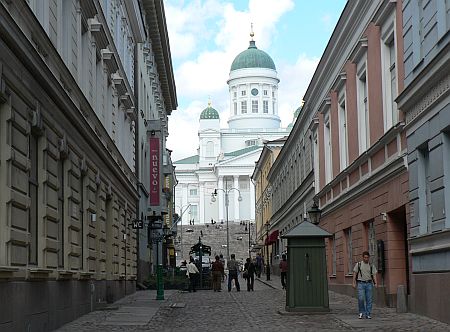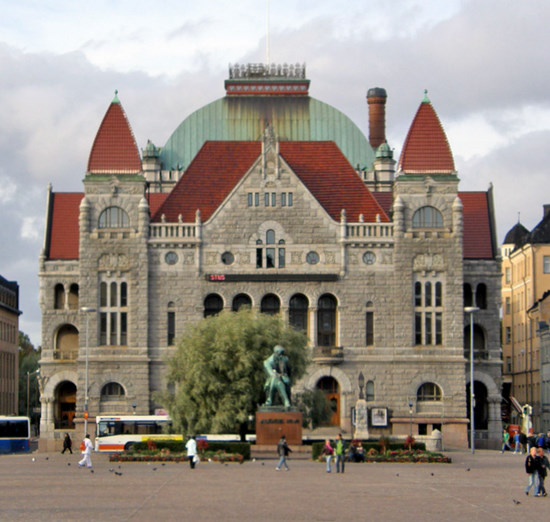In 2005, Finland was rated the #1 environmentally sustainable country in the world. While old Finish traditions mix with the latest contemporary trends to push the city into the next millennium, the people of Finland deserve a pat on the back for knowing it is their responsibility to protect their environment and keep Finland green for the next generation.
 Finland’s capital,”green” Helsinki, is far from flashy. The rhythm of the city is laid back, yet at the same time very active in terms of environmental issues. Famous for its quality design and high technology, Helsinki still remains a pocket sized metropolis in comparison to most Euopean capitals. There are no high rise buildings and 19th century architecture remains the city’s landscape. And a full third of the city consists of parks and other green areas! Since the city is compact, it is very easy to get around on foot, although the public transportation system was ranked number two in all of Europe.
Finland’s capital,”green” Helsinki, is far from flashy. The rhythm of the city is laid back, yet at the same time very active in terms of environmental issues. Famous for its quality design and high technology, Helsinki still remains a pocket sized metropolis in comparison to most Euopean capitals. There are no high rise buildings and 19th century architecture remains the city’s landscape. And a full third of the city consists of parks and other green areas! Since the city is compact, it is very easy to get around on foot, although the public transportation system was ranked number two in all of Europe.
With up to 19 hours of sunlight each day during the two months on either side of summer solstice (June 22) summer makes for the perfect time to enjoy and stretch a vacation in Finland. Although taking advantage of the summer hours is great, take note that August is the time when outdoor festivals start to take over the city. Art, music, and food seemed to be at the heart of Finnish life and so you could literally go to a different festival everyday from August to October.
We visited the Green Fingerprint Festival, which featured one of my favorite Finnish bands; Apocalyptica (a Finnish Cello/Rock Quartet.) This festival is part of a nationwide green fingerprint campaign to raise awareness of the need to conserve energy and combat climate change. Citizens can get a free ticket to the event by making a personal pledge to conserve energy. Its small things like this that inspires citizens to take part in the green movement.
 Another coming attraction to the green scene in Helsinki is carbon free, green neighborhoods. The city is setting aside the Jatkasaari district as an eco model for the rest of the world. This will be an urban zone with low or no carbon emissions. Over the next six years, the Jatkasaari district will be designed, constructed and opened to the public. This will highlight the fact that living green is not a made up Utopia. It will instead, demonstrate the benefits of creating a working neighborhood in which people can live healthy and carbon free. Maybe the USA will take note and not be the last country to build and test green neighborhoods that seemed to popping up all over Europe.
Another coming attraction to the green scene in Helsinki is carbon free, green neighborhoods. The city is setting aside the Jatkasaari district as an eco model for the rest of the world. This will be an urban zone with low or no carbon emissions. Over the next six years, the Jatkasaari district will be designed, constructed and opened to the public. This will highlight the fact that living green is not a made up Utopia. It will instead, demonstrate the benefits of creating a working neighborhood in which people can live healthy and carbon free. Maybe the USA will take note and not be the last country to build and test green neighborhoods that seemed to popping up all over Europe.
Of course green hotels are the standard in Helsinki and the Hotel Simonkentta was my home base for exploring the city. This hotel provides guests with organic bath products, garbage bins made from recycled rubber, and containers for separating out recycling material. The hotel chain recently announced that its goal is to have zero carbon dioxide output by 2025. The hotel has started relying on hydro-power, water-efficient taps, and it has eliminated disposable packaging. Guests are encouraged to borrow Scandic bikes during their stay and the hotel prioritizes cars that run on alternative fuels. This hotel also carries the SWAN label, the most trusted Nordic environmental label of its kind. The SWAN label helps consumers and companies make environmentally friendly product choices and encourages manufacturers to develop products with a greater regard for the environment.
As a city designed for outdoor enthusiasts, Helsinki has few rivals. The air is really crisp and unpolluted and the waters are bright blue and clean.It was refreshing to come across a people so invested in the preservation of their city and the planet. We all have a responsibility to protect the environment because in the end Mother Nature doesn’t recognize national borders or passports. I recommend visiting Finland anytime of the year, but remember to bring your below zero gear in the winter and your sunglasses for the long daylight hours in the summer.


Comments